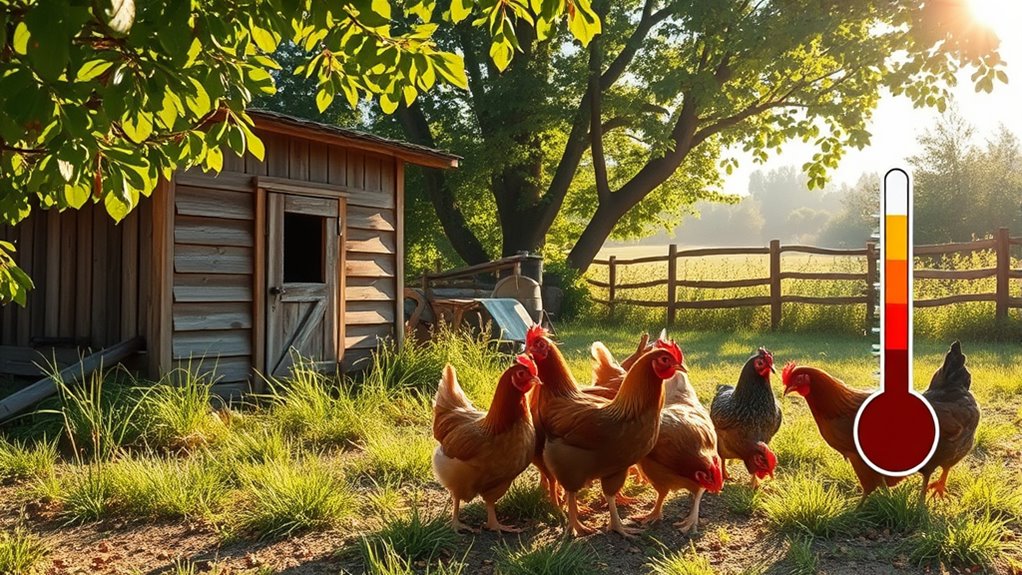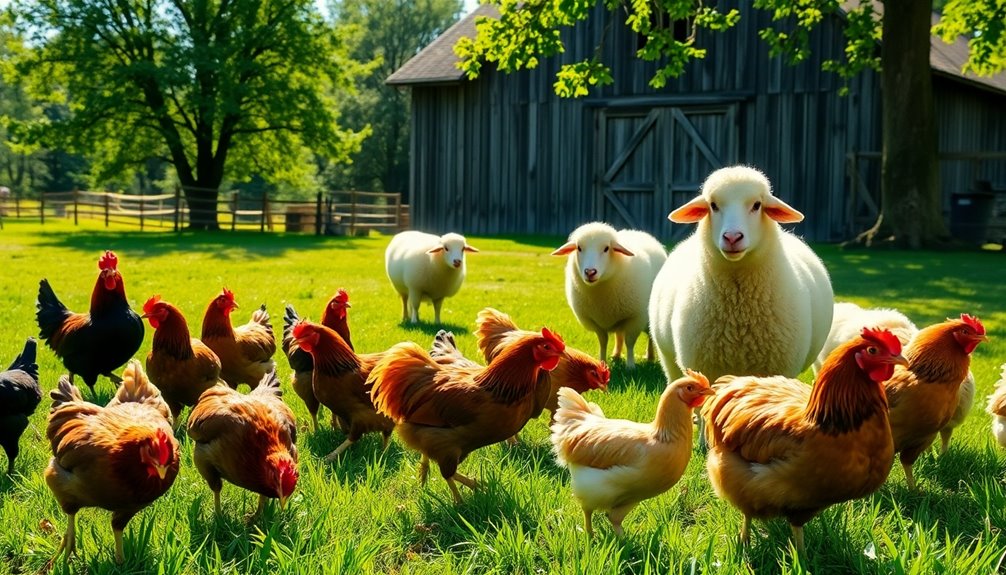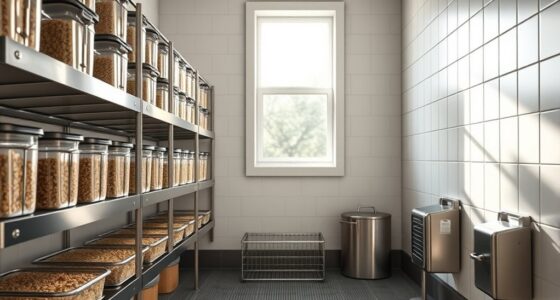To keep your free-range eggs safe and fresh, aim to harvest at temperatures between 55°F and 75°F (13°C to 24°C). Collect eggs during cooler parts of the day and store them in a cool, dry place ideally between 45°F and 50°F. Using a thermometer helps guarantee proper temperature control, preventing bacterial growth and spoilage. Staying vigilant about environmental conditions can make all the difference—you’ll find useful tips if you continue exploring this topic.
Key Takeaways
- Harvest eggs when temperatures are between 55°F and 75°F (13°C to 24°C) to ensure freshness and safety.
- Collect eggs during cooler parts of the day to minimize heat exposure and bacterial growth.
- Store eggs at 45°F to 50°F (7°C to 10°C) in a cool, dry place to maintain quality.
- Use calibrated thermometers to monitor and maintain proper egg and storage temperatures consistently.
- Maintain proper coop ventilation and insulation to prevent temperature fluctuations and protect egg safety.
Understanding the Ideal Egg Harvest Temperature
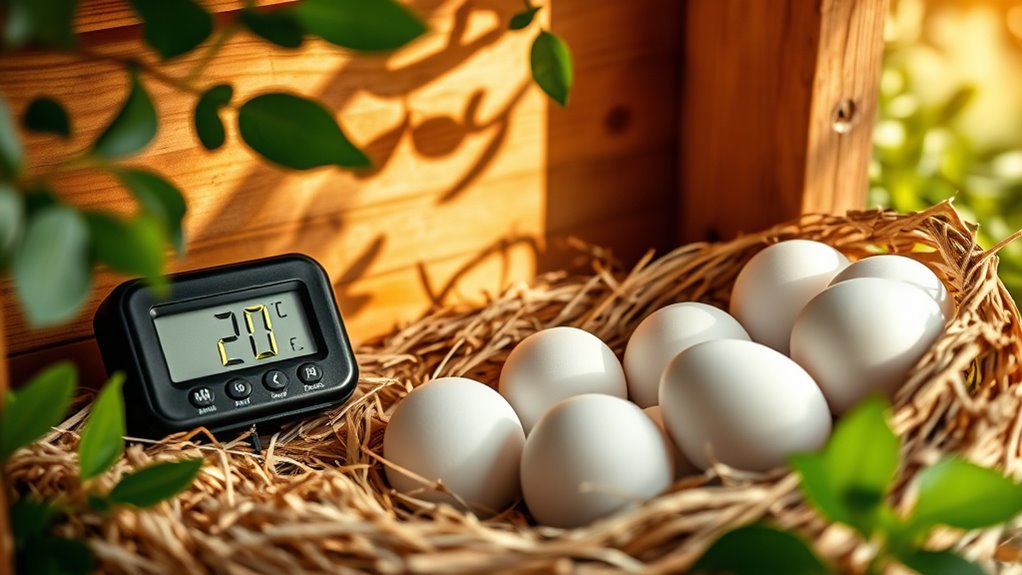
Understanding the ideal egg harvest temperature is crucial for ensuring both egg quality and safety. Eggshell porosity plays a key role here, as it influences how gases and moisture exchange with the environment. When hens are exposed to inappropriate temperatures, their shells may become more porous, increasing the risk of bacterial contamination and compromising egg integrity. Additionally, keeping the correct harvest temperature supports hen health, reducing stress and preventing issues like shell thinning or abnormal shell formation. Maintaining a stable environment ensures that the eggs are collected at their freshest and safest point. Proper environmental controls can also reduce the likelihood of bacterial growth on eggshells, further enhancing safety. Controlling temperature fluctuations is essential for maintaining egg shell quality and preventing cracks or defects that can harbor bacteria. By controlling temperature conditions, you help preserve eggs’ natural defenses, minimize contamination risks, and promote overall hen well-being. This balance is essential for producing high-quality, safe free-range eggs. Implementing data-driven strategies can further optimize environmental conditions and enhance overall egg safety and quality, especially considering the impact of automation technologies on environmental management.
Temperature Range for Collecting Fresh Eggs
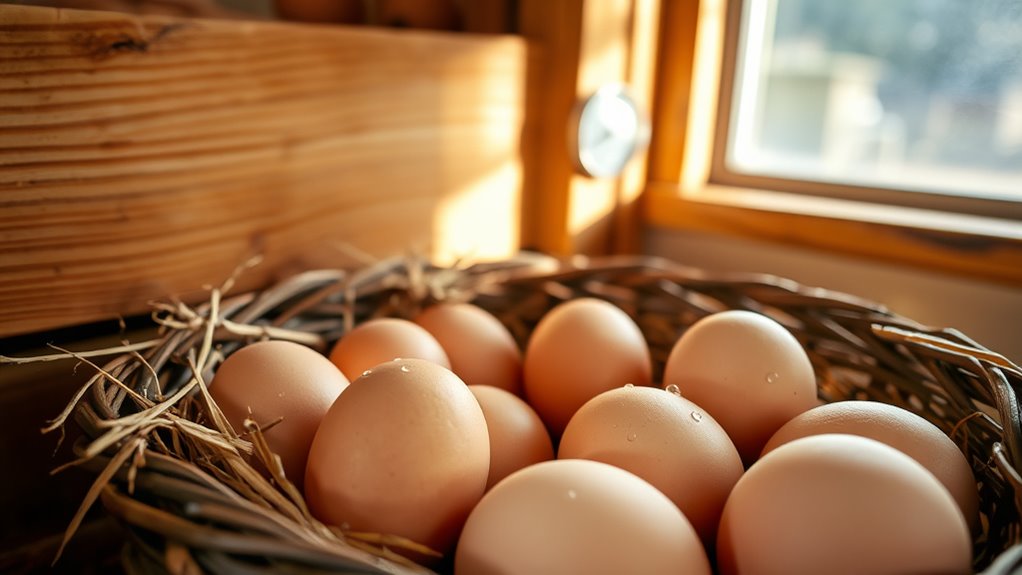
To guarantee you collect the freshest eggs, it’s important to keep the temperature within an ideal range. Eggs are sensitive to temperature fluctuations, which can affect eggshell porosity and overall quality. The optimal temperature for collecting eggs is between 55°F and 75°F (13°C to 24°C), ensuring eggs don’t develop bacterial growth or spoil. Consider these points:
Keep eggs fresh by collecting within 55°F to 75°F, avoiding temperature fluctuations that harm quality.
- Collect eggs during cooler parts of the day to minimize heat exposure.
- Ensure hens have a balanced diet to strengthen eggshells and reduce porosity.
- Avoid collecting eggs immediately after rain or in high humidity, which can compromise shell integrity.
- Store eggs in a cool, dry place to maintain freshness and prevent bacteria infiltration.
- Proper temperature management and diet help preserve egg quality and safety. Maintaining consistent temperatures can also help prevent bacterial growth, which is crucial for food safety. Additionally, monitoring ambient temperatures can aid in preventing spoilage and maintaining egg integrity over time.
- Regularly checking the climate conditions of your henhouse can help optimize egg collection and storage practices.
How to Recognize Proper Egg Freshness by Temperature
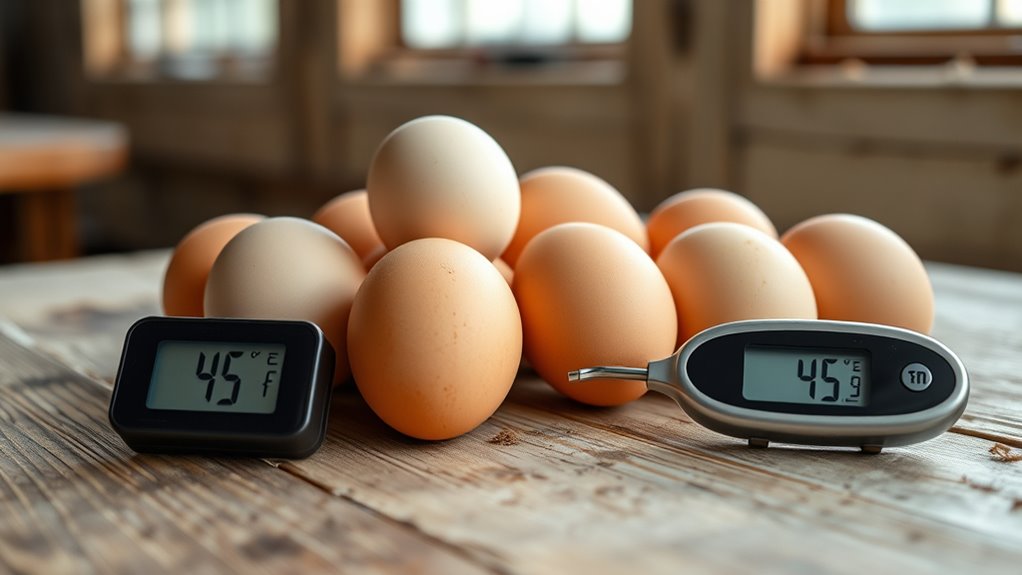
You can tell if eggs are fresh by checking their temperature history—cold storage usually keeps them safe longer, while warm temperatures can speed up spoilage. Look for signs like eggs feeling cool and firm, which indicate they’ve been stored properly. On the other hand, eggs that feel warm or show signs of temperature fluctuation may be nearing spoilage. Maintaining consistent storage conditions is crucial for preserving egg freshness and safety. Additionally, monitoring ambient temperature control during transportation can prevent unexpected spoilage, especially when handling free-range eggs that might be more exposed to environmental changes. Using air purifiers in storage areas can also help maintain optimal air quality and reduce unwanted humidity or pollutants that could affect egg quality.
Cold Storage Indicators
Maintaining the proper temperature during storage is essential for keeping eggs fresh and safe to eat. Cold storage indicators help you verify that the cold chain remains intact. If eggs are stored correctly, they stay within a safe temperature range, preventing bacterial growth. To ensure proper refrigeration techniques, look for these indicators:
- Consistent cold temperatures, ideally between 33°F and 40°F (1°C – 4°C)
- No temperature fluctuations or spikes
- Properly functioning refrigerator thermostats
- Sealed eggs stored in an airtight container
Regularly checking your fridge’s temperature with a thermometer confirms your refrigeration techniques are effective. Avoid storage in the door, where temperatures fluctuate more. Staying vigilant with these indicators preserves egg quality and safety, especially when considering temperature stability for vehicle performance and safety. Proper temperature maintenance also supports optimal vacuum cleaner performance by reducing moisture buildup that can impair components. Ensuring consistent cold temperatures helps prevent spoilage and maintains egg freshness for longer periods, which is especially important in cold storage practices.
Warm Temperature Signs
Warm temperature signs are key indicators that eggs may have lost their freshness or safety. When handling eggs, pay attention to warmth cues that suggest they’ve been exposed to higher temperatures. Eggs stored at unsafe temperatures may develop a noticeable warmth, indicating they’ve gone beyond their best temperature comfort zone. If an egg feels warmer than usual or has been stored in a hot environment, it could signal spoilage or bacterial growth. Proper freshness relies on maintaining consistent, cool temperatures; warmth cues serve as a warning to avoid consuming eggs that may pose health risks. Always check for signs of excessive heat, especially if eggs are stored outside the ideal temperature range. Recognizing these warmth cues helps ensure you harvest and consume only safe, fresh eggs. Additionally, understanding food safety measures can help protect your data and ensure safe handling of digital information related to food safety. Monitoring temperature fluctuations can also help identify food spoilage before eggs reach a hazardous state. Awareness of temperature control practices is essential for maintaining egg quality during storage and transit.
Effects of Temperature Fluctuations on Egg Safety

Temperature fluctuations can markedly compromise egg safety, especially in free-range systems where environmental control is limited. Sudden changes can damage the shell, reducing integrity and increasing the risk of contamination. They also affect nutrient retention, decreasing the egg’s nutritional quality. To understand the impact:
- Shell Weakening: Temperature swings can cause cracks, making eggs more vulnerable to bacteria.
- Nutrient Loss: Fluctuations accelerate nutrient degradation, reducing vitamins and minerals.
- Fungal Growth: Warm periods promote mold and bacterial growth inside eggs.
- Condensation: Rapid cooling causes moisture buildup, which can carry pathogens into the egg.
- Environmental Factors: Exposure to inconsistent temperatures in free-range systems underscores the importance of proper temperature regulation to maintain egg safety. Implementing effective temperature management strategies can help mitigate these risks and preserve egg quality.
Best Practices for Storing Eggs to Maintain Safety
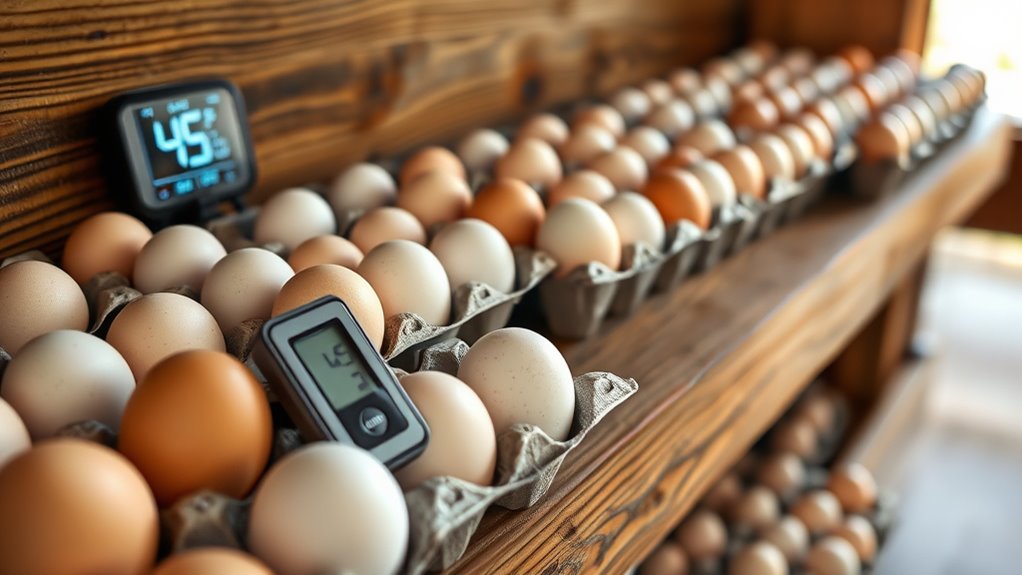
Proper storage methods are essential to keeping eggs safe after they’ve been collected. To preserve egg nutrition and prevent contamination, store eggs in a cool, consistent temperature—ideally between 45°F and 50°F. Avoid washing eggs before storage, as this can remove protective coatings and increase spoilage risk. Instead, keep eggs in their carton to protect them from absorbing odors and contamination. Good coop ventilation is vital during storage because it helps maintain consistent temperatures and reduces humidity, which can promote bacteria growth. Keep eggs away from strong-smelling foods or chemicals. Regularly check stored eggs for cracks or spoilage. Proper storage not only maintains egg safety but also preserves their nutritional value, ensuring you get the most benefit from your free-range eggs.
Using Thermometers for Accurate Harvest and Storage
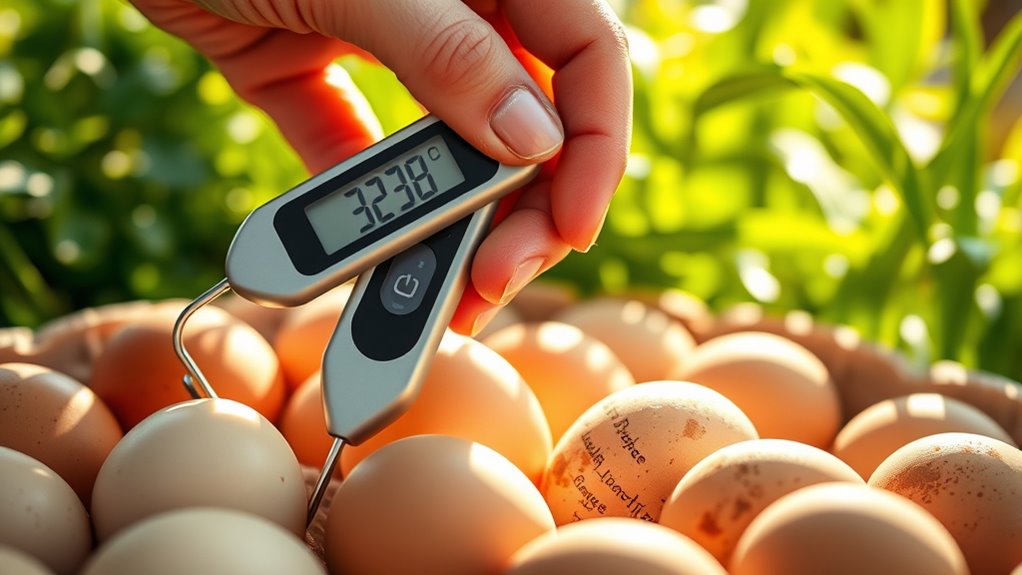
Using a thermometer guarantees you harvest and store eggs at the correct temperature, keeping them safe to eat. You need to choose the right type, monitor temperatures regularly, and follow proper storage methods. This simple step helps prevent spoilage and maintains egg quality.
Choosing the Right Thermometer
Choosing the right thermometer is essential for accurately monitoring harvest and storage temperatures of your free-range eggs. An accurate thermometer helps prevent temperature fluctuations that could compromise eggshell integrity and poultry health. To select the best one, consider these points:
- Type: Use digital or dial thermometers for quick, precise readings.
- Range: Ensure it covers the ideal harvest and storage temperatures.
- Accuracy: Look for models with ±1°F precision.
- Durability: Choose water-resistant, easy-to-clean options suitable for farm environments.
Proper thermometer choice helps you maintain safe temperatures, protecting eggs from spoilage and ensuring poultry health. Consistent temperature monitoring reduces the risk of eggshell damage caused by thermal stress, supporting overall farm productivity.
Monitoring Egg Temperature
Accurate temperature monitoring is key to maintaining ideal conditions for your eggs during harvest and storage. Using a reliable thermometer helps guarantee you detect the right moment to harvest, preserving eggshell integrity and preventing damage. When eggs are too warm, shells can weaken, increasing the risk of cracks and contamination. Monitoring temperature also supports hen health by indicating if the environment is too hot or cold, which may stress your flock. Regularly checking egg temperature during collection ensures you handle eggs at the optimal time, reducing spoilage and maintaining quality. Keep your thermometer calibrated for precision, and record readings to track temperature trends. This active approach helps you make informed decisions, ultimately protecting both your hens’ health and the safety of your eggs.
Proper Storage Practices
To guarantee your eggs stay fresh and safe, proper storage practices must include monitoring storage temperatures with reliable thermometers. Eggshell porosity allows moisture transfer, so maintaining an ideal temperature prevents spoilage and preserves egg quality. Additionally, consistent storage conditions help keep the egg yolk color vibrant, indicating freshness. To achieve this, consider these key practices:
- Store eggs at 35–40°F (1.7–4.4°C) in a consistent environment.
- Use a thermometer to verify storage temperature regularly.
- Keep eggs in the main body of the fridge, not the door, to avoid temperature fluctuations.
- Avoid excessive handling, which can damage eggshell porosity and compromise storage integrity.
Following these steps ensures your eggs remain safe, fresh, and visually appealing.
Tips for Maintaining Consistent Temperatures in Your Coop
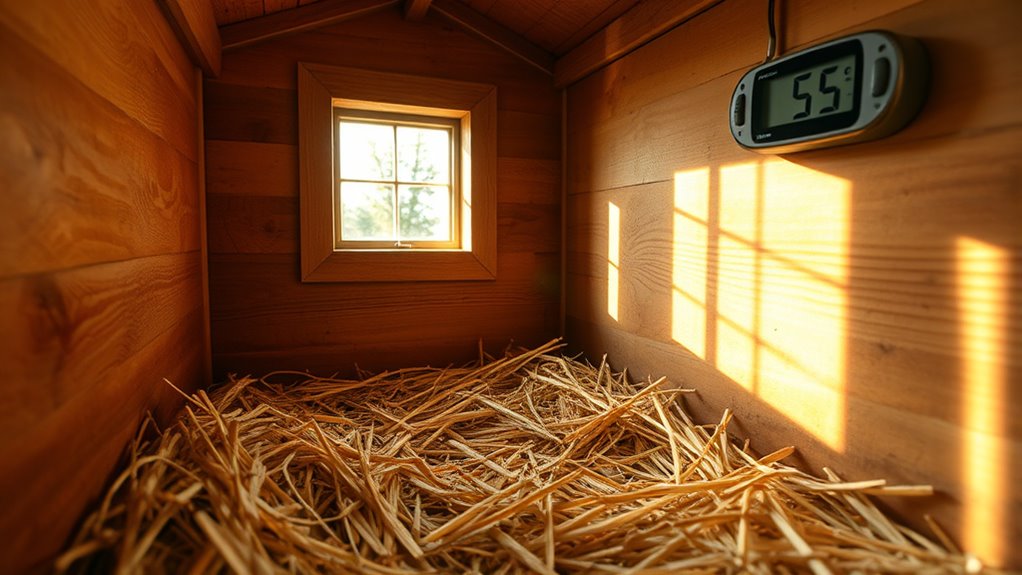
Maintaining a consistent temperature in your coop is essential for the health and productivity of your hens. Proper coop ventilation helps regulate airflow, preventing hot spots or cold drafts that can stress your chickens. Guarantee vents are adjustable to control humidity and temperature effectively. Keep the coop well-insulated to maintain stable temperatures during extreme weather. Regularly check for predators and reinforce openings to prevent them from disturbing the environment or causing temperature fluctuations. Using shaded areas or adding fans in summer and heaters in winter can help stabilize temperatures. Consistent conditions reduce stress and improve egg quality. By focusing on good ventilation and predator prevention, you create a safe, comfortable space that supports your hens’ health and ideal egg production.
Frequently Asked Questions
How Do Outdoor Weather Conditions Affect Safe Egg Harvest Temperatures?
Outdoor weather conditions can considerably impact safe egg harvest temperatures. You should regularly monitor the weather to prevent eggs from getting too hot or cold, which can affect egg freshness and safety. Extreme temperatures may cause eggs to spoil or become unsafe to eat. By keeping an eye on weather conditions, you help guarantee ideal harvest temperatures, preserving egg quality and freshness for consumers.
Can Temperature Variations Impact the Nutritional Quality of Free-Range Eggs?
Imagine your eggs turning into tiny nutritional time capsules! Temperature variations can seriously impact nutrient preservation and egg freshness, making them lose their superpowers faster than you can say “breakfast.” When eggs are exposed to extreme heat or cold, their delicate nutrients degrade, and freshness diminishes. So, keeping eggs at consistent, ideal temperatures helps you enjoy maximum nutritional benefits and fresh-tasting eggs every time.
Are There Specific Temperature Guidelines for Different Chicken Breeds?
You should know that breed-specific incubation guidelines influence ideal temperatures for egg care. Different chicken breeds have unique needs, affecting egg freshness preservation and hatch success. By following breed-specific incubation protocols, you guarantee the eggs develop properly and stay fresh longer. Always research your chicken breed’s temperature requirements, as maintaining the right conditions helps preserve egg quality and promotes healthy hatching, giving your flock the best start possible.
How Often Should I Check Coop Temperature During Different Seasons?
You should check your coop temperature regularly to guarantee your chickens stay comfortable, especially during seasonal changes. In winter, monitor more frequently to prevent cold stress, and in summer, keep an eye out for overheating. Proper coop insulation helps maintain stable temperatures, reducing the need for constant adjustments. Adjust your checks based on seasonal fluctuations, aiming to keep the environment safe and cozy for your flock year-round.
What Are the Risks of Harvesting Eggs Outside Recommended Temperature Ranges?
If you harvest eggs outside recommended temperatures, you risk compromising egg freshness and shell integrity. Warmer temperatures can cause eggs to spoil faster, increasing bacterial growth, while colder temps may lead to cracks or weakened shells. This not only affects egg quality but also raises food safety concerns. Always aim to harvest eggs within safe temperature ranges to guarantee they stay fresh, intact, and safe for consumption.
Conclusion
Think of your eggs as delicate treasures, like rare jewels needing just the right environment to shine. By keeping harvest and storage temperatures steady, you’re guiding them safely through their journey, avoiding the stormy fluctuations that can spoil their worth. With careful attention and a steady hand, you become the guardian of these precious gems, ensuring they stay fresh and safe for every meal. Your vigilance turns everyday eggs into a secure, nourishing treasure chest.

